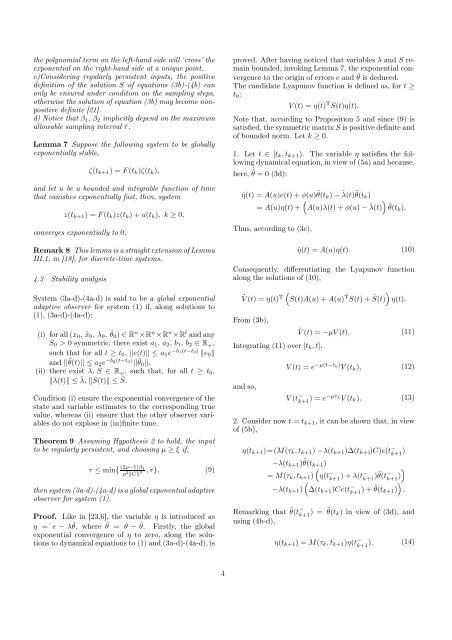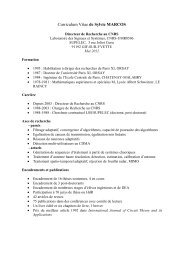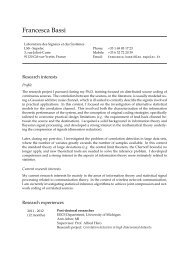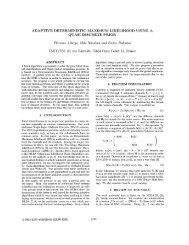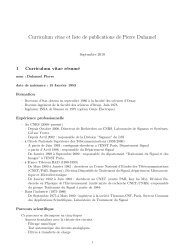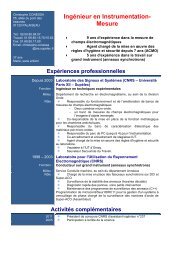THÈSE DE DOCTORAT Ecole Doctorale « Sciences et ...
THÈSE DE DOCTORAT Ecole Doctorale « Sciences et ...
THÈSE DE DOCTORAT Ecole Doctorale « Sciences et ...
You also want an ePaper? Increase the reach of your titles
YUMPU automatically turns print PDFs into web optimized ePapers that Google loves.
the polynomial term on the left-hand side will ‘cross’ the<br />
exponential on the right-hand side at a unique point.<br />
c)Considering regularly persistent inputs, the positive<br />
definition of the solution S of equations (3b)-(4b) can<br />
only be ensured under condition on the sampling steps,<br />
otherwise the solution of equation (3b) may become nonpositive<br />
definite [21].<br />
d) Notice that β 1 , β 2 implicitly depend on the maximum<br />
allowable sampling interval ¯τ.<br />
Lemma 7 Suppose the following system to be globally<br />
exponentially stable,<br />
ζ(t k+1 ) = F(t k )ζ(t k ),<br />
and l<strong>et</strong> u be a bounded and integrable function of time<br />
that vanishes exponentially fast, then, system<br />
z(t k+1 ) = F(t k )z(t k ) + u(t k ), k ≥ 0,<br />
converges exponentially to 0.<br />
Remark 8 This lemma is a straight extension of Lemma<br />
III.1, in [18], for discr<strong>et</strong>e-time systems.<br />
4.3 Stability analysis<br />
System (3a-d)-(4a-d) is said to be a global exponential<br />
adaptive observer for system (1) if, along solutions to<br />
(1), (3a-d)-(4a-d):<br />
(i) for all (x 0 , ˆx 0 , λ 0 , ˆθ 0 ) ∈ R n ×R n ×R n ×R l and any<br />
S 0 > 0 symm<strong>et</strong>ric, there exist a 1 , a 2 , b 1 , b 2 ∈ R + ,<br />
such that for all t ≥ t 0 , ‖e(t)‖ ≤ a 1 e −b1(t−t0) ‖e 0 ‖<br />
and ||˜θ(t)|| ≤ a 2 e −b2(t−t0) ||˜θ 0 ||.<br />
(ii) there exist ¯λ, ¯S ∈ R + , such that, for all t ≥ t 0 ,<br />
‖λ(t)‖ ≤ ¯λ, ‖S(t)‖ ≤ ¯S.<br />
Condition (i) ensure the exponential convergence of the<br />
state and variable estimates to the corresponding true<br />
value, whereas (ii) ensure that the other observer variables<br />
do not explose in (in)finite time.<br />
Theorem 9 Assuming Hypothesis 2 to hold, the input<br />
to be regularly persistent, and choosing µ ≥ ξ if,<br />
τ ≤ min{ (2ρ−1)β1<br />
ρ 2 ‖C‖ 2 , ¯τ}, (9)<br />
then system (3a-d)-(4a-d) is a global exponential adaptive<br />
observer for system (1).<br />
Proof. Like in [23,6], the variable η is introduced as<br />
η = e − λ˜θ, where ˜θ = θ − ˆθ. Firstly, the global<br />
exponential convergence of η to zero, along the solutions<br />
to dynamical equations to (1) and (3a-d)-(4a-d), is<br />
proved. After having noticed that variables λ and S remain<br />
bounded, invoking Lemma 7, the exponential convergence<br />
to the origin of errors e and ˜θ is deduced.<br />
The candidate Lyapunov function is defined as, for t ≥<br />
t 0 :<br />
V (t) = η(t) T S(t)η(t).<br />
Note that, according to Proposition 5 and since (9) is<br />
satisfied, the symm<strong>et</strong>ric matrix S is positive definite and<br />
of bounded norm. L<strong>et</strong> k ≥ 0.<br />
1. L<strong>et</strong> t ∈ [t k , t k+1 ). The variable η satisfies the following<br />
dynamical equation, in view of (5a) and because,<br />
here, ˙˜θ = 0 (3d):<br />
˙η(t) = A(u)e(t) + φ(u)˜θ(t k ) − ˙λ(t)˜θ(t k )<br />
(<br />
˙λ(t))<br />
= A(u)η(t) + A(u)λ(t) + φ(u) − ˜θ(tk ).<br />
Thus, according to (3c),<br />
˙η(t) = A(u)η(t). (10)<br />
Consequently, differentiating the Lyapunov function<br />
along the solutions of (10),<br />
˙V (t) = η(t) T (<br />
S(t)A(u) + A(u) T S(t) + Ṡ(t) )<br />
η(t).<br />
From (3b),<br />
Integrating (11) over [t k , t],<br />
and so,<br />
˙V (t) = −µV (t). (11)<br />
V (t) = e −µ(t−t k) V (t k ), (12)<br />
V (t − k+1 ) = e−µτ k<br />
V (t k ). (13)<br />
2. Consider now t = t k+1 , it can be shown that, in view<br />
of (5b),<br />
η(t k+1 )=(M(τ k , t k+1 ) −λ(t k+1 )∆(t k+1 )C)e(t − k+1 )<br />
−λ(t k+1 )˜θ(t k+1 )<br />
)<br />
= M(τ k , t k+1 )<br />
(η(t − k+1 ) + λ(t− k+1 )˜θ(t − k+1<br />
(<br />
−λ(t k+1 ) ∆(t k+1 )Ce(t − k+1 ) + ˜θ(t<br />
)<br />
k+1 ) .<br />
Remarking that ˜θ(t − k+1 ) = ˜θ(t k ) in view of (3d), and<br />
using (4b-d),<br />
η(t k+1 ) = M(τ k , t k+1 )η(t − k+1<br />
). (14)<br />
4


